
9 minute read
IT'S FINALLY HERE
The wait is over; the all-new 2024 Ford Ranger Raptor is coming to North America. Ranger Raptor is based on a proven legacy of performance and built with uncompromised suspension design, power, purposeful technology, and rugged styling. Ranger Raptor is fully prepared to take on the most demanding terrain its extreme adventure-seeking customers can find.
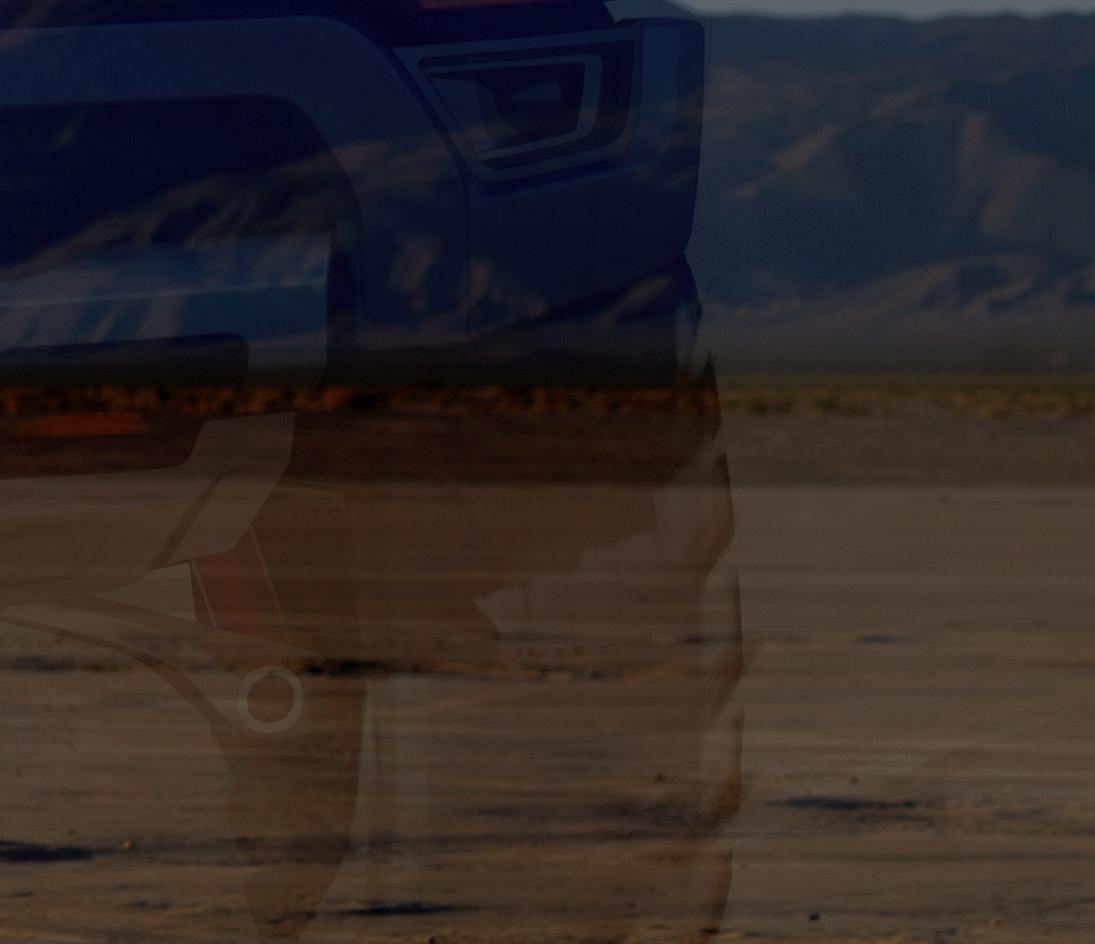



Confident Suspension, Purposeful Tech
The heart of every Raptor is its suspension. Ranger Raptor starts with a purpose-built suspension that includes lightweight aluminum upper and lower control arms and a long-travel rear suspension with a Watts linkage and trailing arms for control and confidence in off-road conditions.

Ranger Raptor’s next-generation FOX™ 2.5-inch Live Valve Internal Bypass shocks are coil-overs at the front and piggyback reservoirs at the rear to reduce heat buildup for uninterrupted performance all day long.
Ranger Raptor is built on a beefy foundation, taking Ranger’s fully boxed frame up a notch by reinforcing the front frame rails, front shock towers, rear shock brackets, suspension mounting points, and other key areas so Ranger Raptor can handle more punishing off-road conditions.
The FOX™ Live Valve Internal Bypass system changes damping performance based on Ranger Raptor’s Drive Modes. The modes include Normal, Tow/Haul, Sport, Slippery, Off-Road, Rock Crawl, and Baja, all developed to provide better on-road comfort, off-road control, capability and ride quality at high and low speeds.

Each selectable drive mode appropriately adjusts the tuning of the engine, transmission, ABS calibration, traction control, steering, throttle response and even the instrument cluster and touch screen look and information. The active valve exhaust system can also be tuned to several modes including Quiet, Normal, Sport and Baja settings. Ranger Raptor also comes with Trail Control™ so drivers can navigate tricky spots while the truck manages the throttle and brakes.

Powertrain Fit for a Class of One
An amazing suspension deserves to be backed by a matching level of power. The Ford Performance tuned twin-turbo 3.0-liter EcoBoost® V6 produces 430 lb.ft. of torque and best-in-class maximum available 405 horsepower,** the most powerful Ranger ever built for increased performance on gravel, dirt, mud and sand.
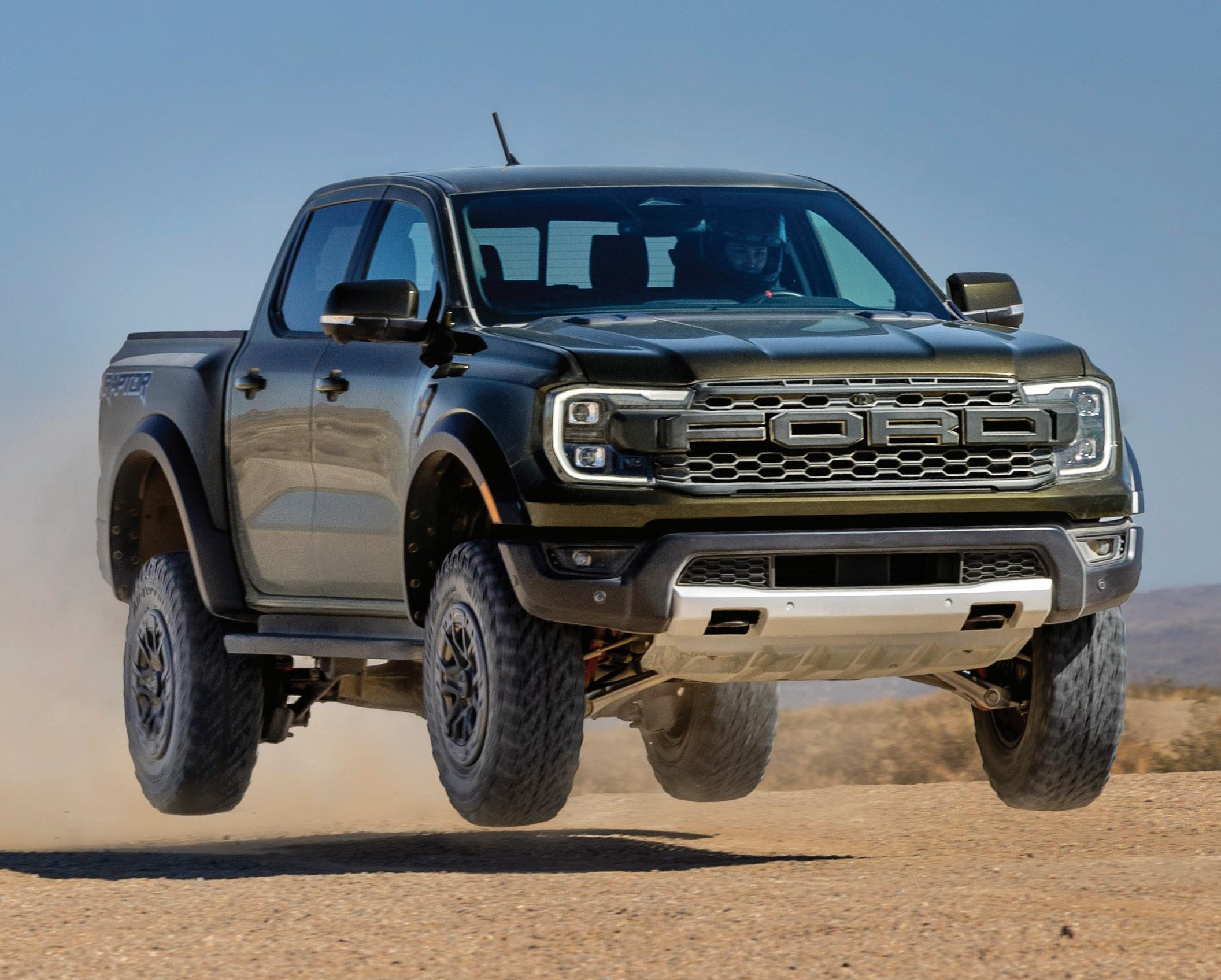
Beginning with a compacted graphiteiron cylinder block, the engine utilizes a race-bred anti turbo-lag system to enable boost on demand in Baja mode. It keeps the turbochargers spinning for up to three seconds after the driver backs off the throttle, so acceleration is there while exiting corners. Bolted to that EcoBoost engine is a class-exclusive 10-speed SelectShift® automatic transmission* mated to an advanced four-wheel drive system with a new electronically controlled on-demand two-speed transfer case combined with front and rear locking differentials.
Designed for Purpose
Each Ranger Raptor design element has a purpose. Confident, modern styling starts with LED projector headlights to light up the night flanked by C-clamp signature lighting. Bold F-O-R-D lettering on the grille sits above an all-steel bumper with integrated, frame-mounted front and rear tow hooks and LED taillights that provide a signature C-clamp link to the front. Flared fenders with functional fender vents house aggressive 33-inch BFGoodrich® all-terrain KO3® tires on 17-inch wheels that can be mounted to optional beadlock capable wheels with available bead locks for running extra low tire pressures in sand and rocky conditions. Ranger Raptor also sports serious underbody protection. The thick front bash plate is made of high-strength steel and is complemented by dedicated engine, transfer case and fuel tank shields.
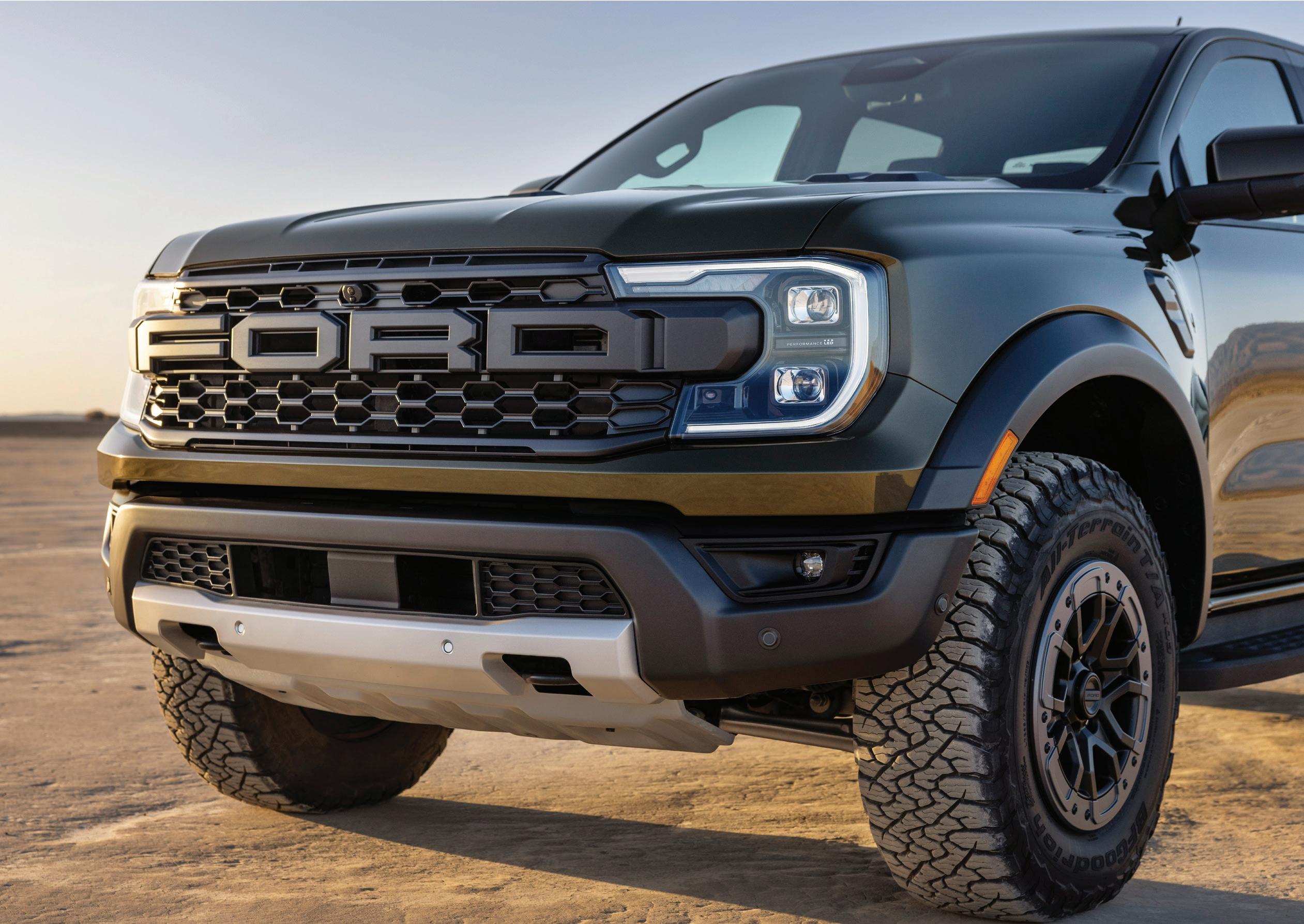
The Raptor’s cab is built for performance, with a sport steering wheel including cast magnesium alloy paddle shifters for quick transmission control and a signature Raptor centering mark in a Code Orange color. Six overhead upfitter switches mounted in the overhead console simplify powering off-road hardware. Unique Ford Performance front seats are supportive, with extra bolstering to hold drivers in place during high-speed cornering. The rest of the cab includes premium materials trimmed in Code



Orange.
Ranger Raptor connects the driver to adventure with features like a 360-Degree Camera and Front View Camera to assist in off-roading, Zone Lighting to light up the night in remote locations, and classexclusive* Pro Trailer Backup Assist† to help back up boats and campers at the kinds of remote locations Raptors are built to reach. Even far out there, drivers want to be informed and connected, so Raptor comes with a high-resolution 12.4-inch digital instrument cluster and 12-inch center touchscreen running SYNC® 4A, Apple CarPlay® and Android Auto™ wireless smartphone connectivity. Finally, \if the active exhaust doesn’t provide enough auditory stimulation, there’s a Bang & Olufsen® sound system to pump out your favorite soundtracks.

The Ford Raptor family spans across its truck and SUV portfolio. F-150 Raptor,
F-150 Raptor R, Bronco Raptor, and now Ranger Raptor are all built for the passionate performance enthusiast who wants a truck to tackle their biggest adventures.
The 2024 Ford Ranger Raptor will be proudly assembled at the Michigan Assembly Plant in Wayne, Michigan with orders beginning in June and availability late this summer.

Ford Performance Preps to Race Ranger Raptor T1+ in Dakar Rally
An extreme racing version of the Ford Ranger® will lead the expansion of Ford Performance global off-road racing to include the famed Dakar Rally in 2024 and beyond.

Ford Performance has raced and won from Le Mans to Monaco, Daytona to Bathurst and Finke to Ensenada. But it has yet to take on one of the toughest races on the planet – the iconic Dakar Rally.

The first step in the multi-year plan to compete in the Dakar Rally is to finish and learn in collaboration with longtime partners M-Sport and Neil Woolridge Motorsport (NWM) for vehicle development, servicing and event management.
The joint Ford Performance, M-Sport and NWM team has implemented a series of development phases through 2023 and continues testing with the Ranger T1+, based on the previous generation global Ranger, with a 3.5-liter EcoBoost engine. Test races are expected to include Spain’s Baja España Aragón and Morocco’s Rally du Maroc rallies in July and October, respectively, before tackling the Dakar Rally next year.

By David Nehrbass
Many may think that when these words are yelled by a driver, co-driver, or crew member, what happens next is the most critical moment of your life. However, the reality of the situation is what you did that morning before you got in the racecar is likely the most critical element of your racing career.
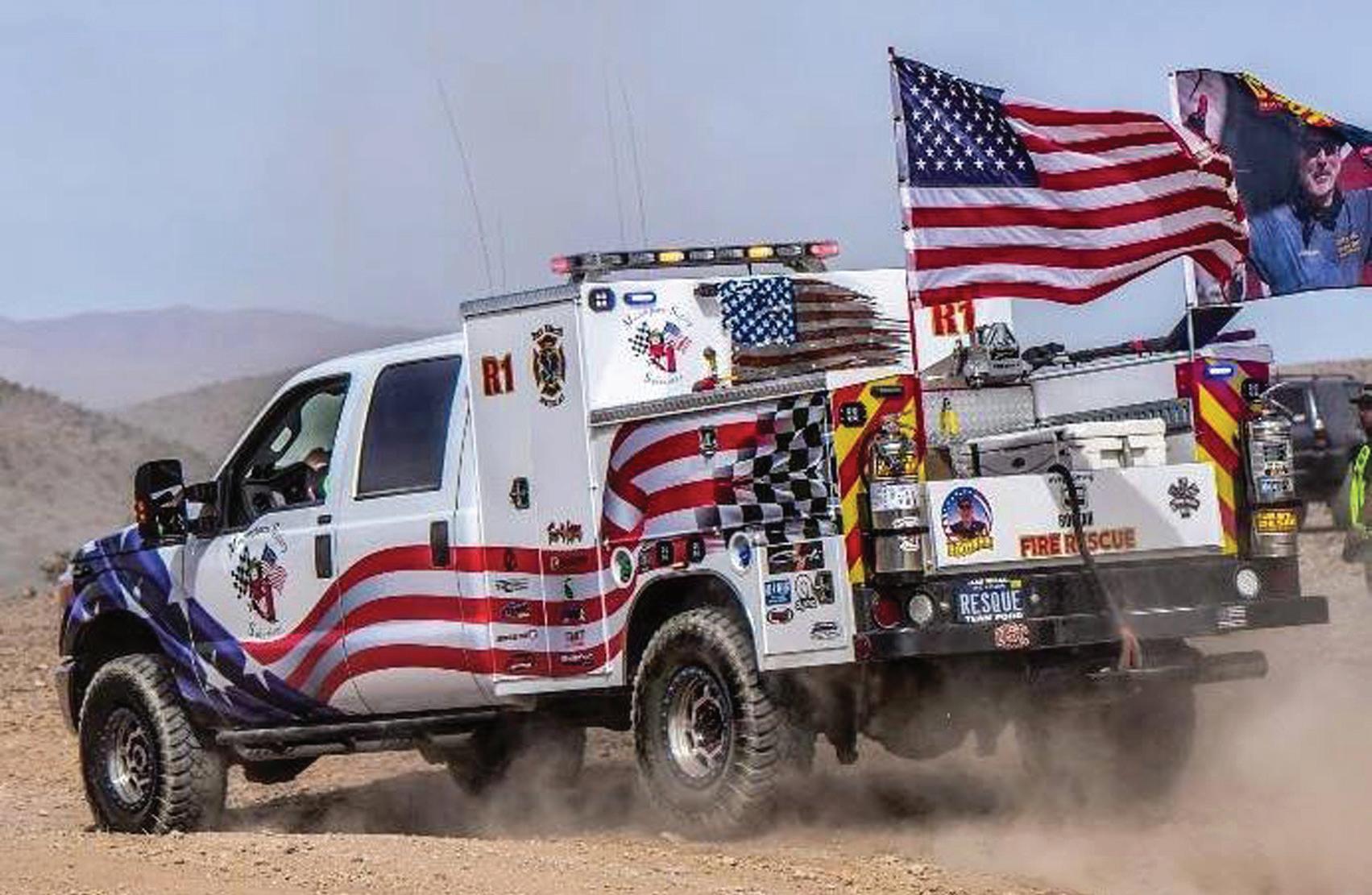
This issue’s Safety-First article has a very personal connection because it deals specifically with a couple of real-life situations in which people were burned recently. Every racing organization has required safety equipment that a racer (and in many cases crew members) must wear. They also often have “Recommended” or “Highly Recommended” garments and equipment added to the rules for their organization. Many also have forbidden items to wear while associated with their race. Old school racers dislike being told what they must wear or what they can’t wear, often out of routine, and personal experience. While what racers and crew do away from a sanctioned event is ultimately up to them, at the races, promoters with established rules should have a reasonable expectation that teams will follow those rules.


Case #1
A vehicle was involved in a rollover accident. The driver self-extracted and the co-driver was trapped in the vehicle as it caught on fi re. The co-driver was unable to get his belts undone and was trapped in the burning vehicle for approximately 30 seconds. The driver, along with race staff, were able to get him out and pull him to safety. The co-driver was not wearing a multi-layer SFI 3,2A/5 suit as required by the racing organization. To make matters more critical he was also wearing socks with a nylon-based fabric. After months in the hospital, ultimately this co-driver lost both his legs right to the point where his socks came up to due to damage received from the burns and the melting of the socks to his legs.
Case #2
Just a couple months ago, racer and good friend Patrick Gailey, strapped into his spec truck and tackled a well-known race here in the United States. Charging hard through some nasty terrain he had a power steering failure, ultimately pumping out hot fl uid at a fast rate and covering his helmet, hands, and suit with power steering fl uid. Shortly after becoming covered in the fl uid, a fl ash fi re occurred in a matter of seconds. This experienced driver upon egress of the vehicle lifted his helmet visor slightly for visibility at some point and allowed superheated air to enter his helmet. While wearing gloves, they were nylon-based go-kart gloves that not only have no fi re protection, but rapid melt in the fi re.
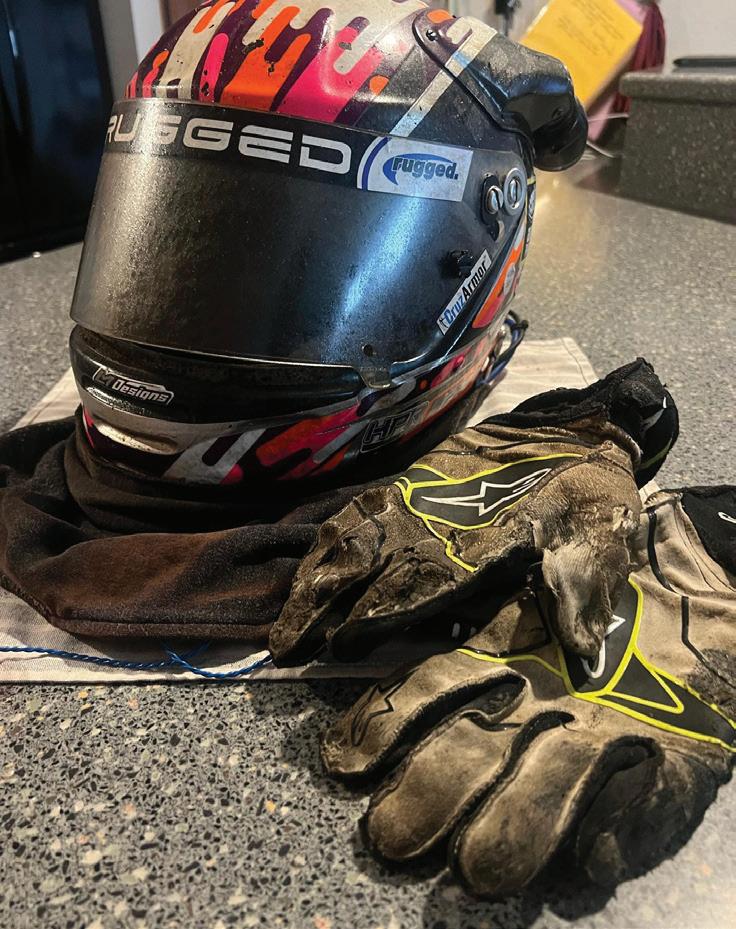
Super heated air can cause massive edema and complications when inhaled. It will kill you faster than the actual exterior


Fire protection should also be a concern for your pit crew burns. While an experienced racer, Patrick didn’t fully embrace the rules established in the rule book. He purchased the gloves he was wearing from a vendor at tech and contingency for a race not realizing they were not SFI rated and were a educate on safety equipment after his very challenging experience. He plans on being a very vocal advocate reminding drivers of the expectations and the ramifi cations of either lack of safety gear or improper safety gear.

In both situations it is impossible with certainty to say that had they followed
Nylon based Alpinestar Go Kart Glove with no SFI rating – Not allowed as defined by most off-road racing series rulebooks
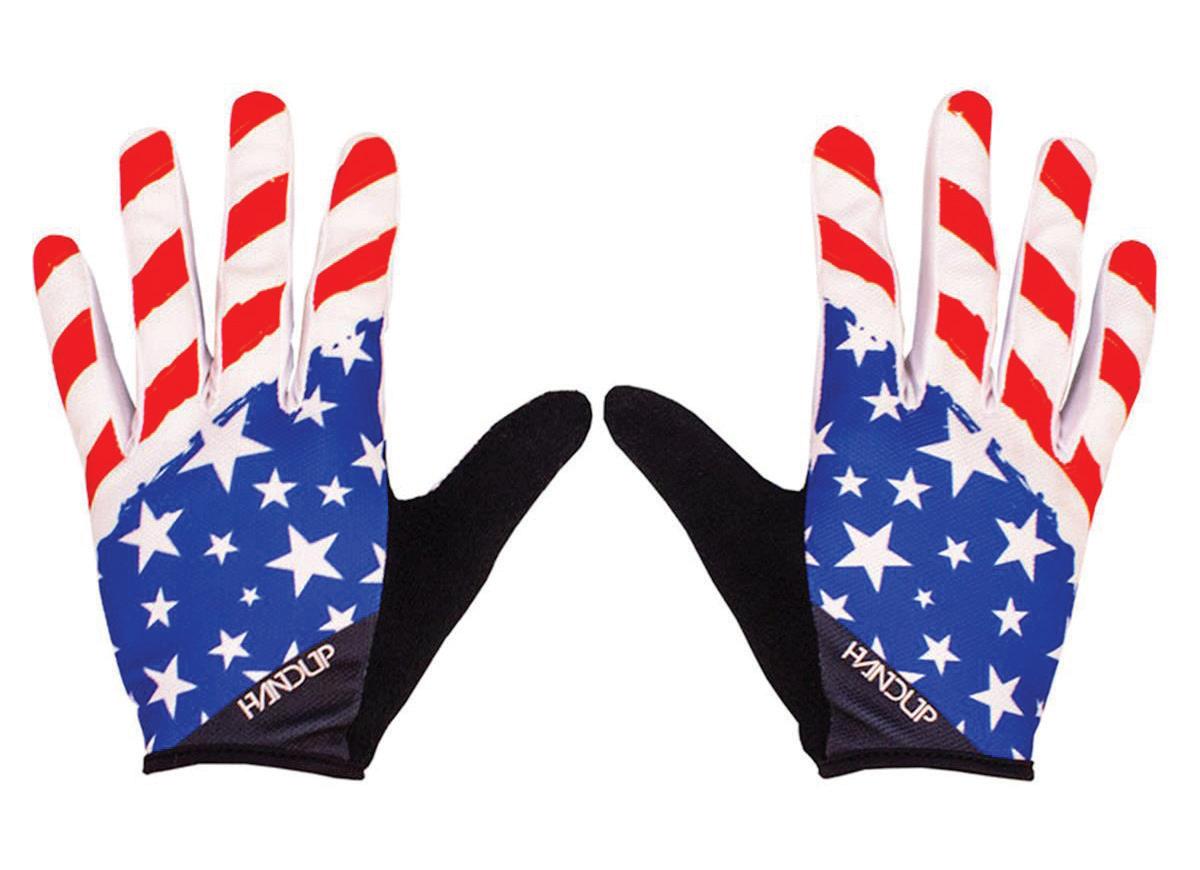

Nylon based motorcycle riding glove with no SFI rating worn by some well-known off road racers – Not allowed as defined by most off-road racing series rulebooks the established rules set by the race promoters, that they would have been fi ne. However, there are years of science, testing, and standards established for a reason in all forms of motorsports. The SFI Foundation sets the gold standard of expectations for Motorsports and spends their lives testing, retesting and continually improving standards for Motorsports Safety expectations.


Gloves are required or recommended in all major Off-Road series. That recommendation carries with it the SFI listing of 3.3/5. Without this SFI tag and listing, your glove is not only not protecting your hands from a fi re but can rapidly melt to your hands and cause more damage than a fl ash fi re.
Since Pat’s injury in March, I have been to numerous off-road events and still see people wearing nylon-based gloves as drivers and co-drivers. Recently in Baja, I watched a friend climb in a TT with the exact same gloves that Pat had been wearing in his incident. We immediately had a talk, and he grabbed his other SFI rated gloves as he headed out. He admittedly knew the hazards but liked the comfort of the glove.
Racing is something we all do for fun. Regardless of what your role on the team is, we all want to have fun. Let’s make sure as a off road community we do the right things, protect ourselves the best we can and try and remember to put Safety First.
In Memoriam –Arnold “Arnie” Kuhns
As I sat down to write this article today, I learned of the passing of Arnie Kuhns. Most people in racing likely have no idea who this iconic leader was but if you have raced any form of Motorsports, ever, you have him to thank for standards in safety related items. Arnie was the founder of the SFI Foundation and took his role incredibly passionate and seriously developing and setting benchmarks for every single item that dealt with safety inside a race vehicle. From suits, helmets and restraints to belts nets and seats. Arnie is who you thank when you crawl out of your racecar after a violent crash.

Arnold “Arnie” Kuhns, safety pioneer and founder of SFI Foundation, passed away peacefully on June 1, surrounded by family. He was 83.
Arnie had a unique background that blended his engineering, production, and business skills into one talented individual. In 1984, Arnie was approached by his peers in the automotive industry to lead the newly formed SFI Foundation to address the increasing concern of inferior parts that posed a risk to safety at the racetrack. Arnie developed what was at the time an innovative system, creating minimum performance testing standards for products to help reduce the frequent failures of parts experienced during that era.
In the beginning, SFI had only two employees managing four product standards for one sanctioning body. Now, SFI testing and certifi cation has grown to a steadfast program with more than one hundred quality assurance specifi cations that are utilized by hundreds of sanctioning bodies internationally.
As a result of Arnie’s hard work and unrelenting belief in doing the right thing, thousands of parts have been tested to safety standards to prove their worth and reliability. That has undoubtedly led to countless lives saved on the racetrack.
He was well-respected in the motorsport safety community due to his high level of integrity. Along the way, Arnie was honored with the Sports Car Club of America George Snively Award for Outstanding Contributions to Motorsports Safety (1995), the United States Auto Club Jack O’Neal Award for Motorsports Safety (1996), inducted into the SEMA Hall of Fame (2002), awarded an NHRA Wally for Valued Personal Contributions to the Sport of Drag Racing and High Performance Industries (2002), SEMA Motorsports Parts Manufacturers Council (MPMC) Hall of Fame (2016), British Drag Racing Hall of Fame’s Lucas Oil Global Achievement Award (2018), and Society of Automotive Engineers (SAE) John Melvin Motorsport Safety Award (2021). During his career he served as President of the International Council of Motorsports Sciences (ICMS) and was an active member of the NFPA 610 Committee for Safety at Motorsports Venues and the Association for the Advancement of Automotive Medicine.
As a person, Arnie was a kind family man and served as a role model to those who worked with him and knew him personally. He will be greatly missed by all.










